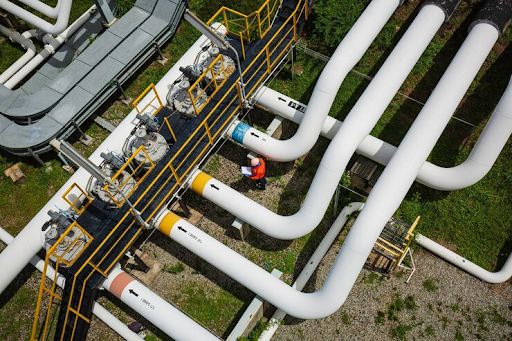In the realm of energy infrastructure, gas pipeline construction plays a crucial role in meeting the growing global demand for natural gas. As societies strive to transition towards cleaner and more sustainable energy sources, natural gas remains a vital component of the energy mix due to its relatively low carbon emissions and abundance.
This article explores the significance of gas pipeline construction in building and maintaining energy infrastructure, highlighting its impact on economic development, energy security, and environmental sustainability.
Understanding Gas Pipeline Construction
Gas pipeline construction involves the planning, design, and implementation of pipelines to transport natural gas from production sites to distribution centers, industrial facilities, and end consumers.
It encompasses a wide range of activities, including route selection, land acquisition, environmental assessments, excavation, welding, and testing. Gas pipelines can vary in size, capacity, and complexity, depending on factors such as distance, terrain, and volume of gas to be transported.
Planning and Route Selection
The first step in gas pipeline construction is meticulous planning and route selection. Engineers and project managers assess various factors, including geological conditions, environmental impact, regulatory requirements, and stakeholder considerations, to determine the optimal route for the pipeline.
This process involves conducting feasibility studies, land surveys, and risk assessments to identify potential challenges and mitigate risks associated with construction and operation.
Design and Engineering
Once the route is finalized, engineers develop detailed design plans for the pipeline, taking into account factors such as pipeline diameter, material selection, pressure requirements, and safety standards.
Advanced modeling and simulation techniques are used to optimize the design and ensure the structural integrity and efficiency of the pipeline system. Engineering teams work closely with regulatory agencies and industry stakeholders to comply with relevant codes and standards governing gas pipeline construction.
Construction and Implementation
The construction phase involves the physical installation of the pipeline along the designated route. This process typically begins with land clearing, excavation, and trenching to prepare the groundwork for laying the pipeline.
Welding crews join individual pipe segments together to form continuous lengths of pipelines, which are then coated and insulated to protect against corrosion and maintain thermal stability. Specialized equipment such as trenchers, cranes, and welding machines are used to facilitate the construction process, while stringent quality control measures ensure compliance with safety and performance standards.
Importance of Gas Pipeline Construction
Gas pipeline construction plays a vital role in supporting economic growth, enhancing energy security, and facilitating the transition to cleaner energy sources. The following sections explore the significance of gas pipelines in the context of energy infrastructure development and their impact on various stakeholders.
Economic Development
Gas pipeline construction stimulates economic activity by creating jobs, generating investment opportunities, and supporting local businesses along the supply chain. Infrastructure projects such as pipelines require skilled labor, materials, and services, providing employment opportunities for workers in construction, manufacturing, engineering, and related industries.
Moreover, the development of gas infrastructure attracts investment in upstream exploration and production activities, driving economic growth in regions with abundant natural gas resources.
Energy Security
Gas pipelines play a critical role in ensuring energy security by diversifying energy sources and reducing dependence on imported fuels. Unlike oil or coal, which must be transported by tanker or rail, natural gas can be delivered efficiently and reliably through pipelines, minimizing the risk of supply disruptions due to geopolitical tensions or transportation bottlenecks.
By establishing a network of interconnected pipelines, countries can enhance their energy resilience and mitigate vulnerabilities associated with reliance on single suppliers or transit routes.
Environmental Sustainability
Despite concerns about greenhouse gas emissions and climate change, natural gas remains a cleaner alternative to traditional fossil fuels such as coal and oil. Gas-fired power plants produce fewer emissions of sulfur dioxide, nitrogen oxides, and particulate matter compared to coal-fired plants, resulting in improved air quality and public health outcomes.
Additionally, advancements in pipeline technology and methane detection systems have led to significant reductions in methane leakage, further enhancing the environmental performance of gas pipelines.
Challenges and Considerations
While gas pipeline construction offers numerous benefits. It also presents challenges and considerations that must be addressed to ensure successful project execution and minimize adverse impacts on communities and the environment.
Environmental Impact
Gas pipeline construction can have significant environmental impacts, including habitat disruption, soil erosion, and water contamination. Projects must undergo rigorous environmental assessments and permitting processes to identify and mitigate potential. Risks to sensitive ecosystems, wildlife habitats, and water resources.
Adopting best practices such as horizontal directional drilling and trenchless construction techniques can help minimize disturbances and preserve natural landscapes.
Social and Community Engagement
Engaging with local communities and stakeholders is essential to building trust, addressing concerns. And fostering positive relationships throughout the project lifecycle. Effective communication and consultation mechanisms enable project developers to solicit feedback, address grievances, and incorporate community input into decision-making processes.
Proactive community engagement can help mitigate social conflicts, enhance project acceptance, and ensure the long-term sustainability of gas pipeline projects.
Regulatory Compliance
Gas pipeline construction is subject to stringent regulatory requirements at the local, national, and international levels. Developers must obtain permits and approvals from regulatory agencies governing land use, environmental protection, safety standards, and public health.
Compliance with regulatory requirements is critical to ensuring project feasibility. Mitigating legal risks, and maintaining public confidence in the integrity and safety of gas pipeline infrastructure.
Future Outlook and Innovation
As the global energy landscape evolves, gas pipeline construction is poised to play an increasingly. Important role in meeting growing energy demand and addressing climate change challenges. Innovations in pipeline technology, digitalization, and renewable energy integration are shaping the future of gas infrastructure development and sustainability.
Digitalization and Smart Pipelines
Advancements in digitalization and sensor technology are transforming the way gas pipelines are monitored, operated, and maintained. Smart pipeline systems equipped with real-time monitoring sensors, remote control capabilities, and predictive analytics enable operators to detect leaks. Optimize performance, and respond promptly to operational anomalies.
Digital twin modeling and simulation techniques facilitate asset management and decision-making. Enhancing the safety, reliability, and efficiency of gas pipeline networks.
Renewable Gas and Hydrogen Infrastructure
The emergence of renewable gas and hydrogen technologies presents. New opportunities for diversifying the energy mix and decarbonizing the gas sector. Renewable gas, produced from organic waste, biomass, or synthetic processes. Can be injected into existing gas pipelines and blended with natural gas. To reduce carbon emissions and enhance energy sustainability.
Similarly, hydrogen infrastructure development, including pipelines for hydrogen transportation and storage. Is gaining momentum as governments and industry stakeholders explore low-carbon alternatives to fossil fuels.
Carbon Capture and Storage (CCS)
Carbon capture and storage (CCS) technologies offer a promising pathway for reducing greenhouse gas emissions from gas-fired power generation and industrial facilities. CCS involves capturing CO2 emissions from point sources such as power plants or industrial processes. Transporting the captured CO2 via pipelines, and injecting it into geological formations for long-term storage.
Gas pipeline infrastructure plays a critical role in transporting CO2 from capture facilities to storage sites. Enabling the deployment of CCS at scale and facilitating the transition to a low-carbon energy future.
Conclusion
Gas pipeline construction is a cornerstone of energy infrastructure development, supporting economic growth, enhancing energy security, and advancing environmental sustainability. As the global demand for natural gas continues to rise, the role of gas pipelines in facilitating. The efficient and reliable transportation of gas remains indispensable.
By addressing challenges, embracing innovation, and adopting sustainable practices. The gas industry can build resilient and future-ready pipeline networks that meet. The evolving needs of society while minimizing environmental impact and maximizing social benefit. As we look to the future, gas pipeline construction will continue to play a vital role in shaping the. Energy landscape and powering the transition to a more




